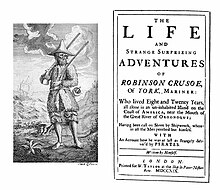
Back Robinson Crusoe AF روبنسون كروزو (رواية) Arabic روبنسون كروزو (روايه) ARZ ৰবিনছন ক্ৰুছো AS Robinson Crusoe AST Robinson Crusoe (suterot) AVK Robinzon Kruzo AZ Рабінзон Круза BE Рабінзон Круза BE-X-OLD Робинзон Крузо (книга) Bulgarian
This article needs additional citations for verification. (May 2022) |
 Title page from the first edition | |
| Author | Daniel Defoe |
|---|---|
| Original title | The Life and Strange Surprizing Adventures of Robinson Crusoe, of York, Mariner: Who lived Eight and Twenty Years, all alone in an un-inhabited Island on the Coast of America, near the Mouth of the Great River of Oroonoque; Having been cast on Shore by Shipwreck, wherein all the Men perished but himself. With An Account how he was at last as strangely deliver'd by Pyrates. Written by Himself. |
| Country | Great Britain |
| Language | English |
| Genre | Adventure, historical fiction |
| Set in | England, the Caribbean and the Pyrenees, 1651–1687 |
| Publisher | William Taylor |
Publication date | 25 April 1719 |
| 823.51 | |
| LC Class | PR3403 .A1 |
| Followed by | The Farther Adventures of Robinson Crusoe |
| Text | Robinson Crusoe at Wikisource |
Robinson Crusoe[a] (/ˈkruːsoʊ/ KROO-soh) is an English adventure novel by Daniel Defoe, first published on 25 April 1719. Written with a combination of Epistolary, confessional, and didactic forms, the book follows the title character (born Robinson Kreutznaer) after he is cast away and spends 28 years on a remote tropical desert island near the coasts of Venezuela and Trinidad, encountering cannibals, captives, and mutineers before being rescued. The story has been thought to be based on the life of Alexander Selkirk,[2] a Scottish castaway who lived for four years on a Pacific island called "Más a Tierra" (now part of Chile) which was renamed Robinson Crusoe Island in 1966.[3]: 23–24 [4] Pedro Serrano is another real-life castaway whose story might have inspired the novel.[5][6]
The first edition credited the work's protagonist Robinson Crusoe as its author, leading many readers to believe he was a real person and that the book was a non-fiction travelogue.[7] Despite its simple narrative style, Robinson Crusoe was well received in the literary world and is often credited as marking the beginning of realistic fiction as a literary genre. It is generally seen as a contender for the first English novel.[8] Before the end of 1719, the book had already run through four editions, and it has gone on to become one of the most widely published books in history, spawning so many imitations, not only in literature but also in film, television, and radio, that its name is used to define a genre, the Robinsonade.[9]
- ^ Defoe, Daniel (1998-06-10) [1719]. Robinson Crusoe. Courier Corporation. hdl:20.500.12024/K061280.000. ISBN 9780486404271.
- ^ Magazine, Smithsonian. "The Real Robinson Crusoe". Smithsonian Magazine. Retrieved 2023-11-05.
- ^ Severin, Tim (2002). In Search of Robinson Crusoe. New York, NY: Basic Books. ISBN 0-465-07698-X.
- ^ "Rescue of Real-Life Robinson Crusoe". education.nationalgeographic.org. Retrieved 2023-09-06.
- ^ "Pedro Serrano, el náufrago español que sobrevivió 8 años en una isla caribeña: inspiró a Robinson Crusoe". El Español (in Spanish). 2021-06-28. Retrieved 2023-11-05.
- ^ Brule, Álvaro Van den (2019-09-07). "El Robinson Crusoe español: la increíble peripecia del náufrago que inspiró a Defoe". elconfidencial.com (in Spanish). Retrieved 2023-11-05.
- ^ Heitman, Danny (2013-01-11). "Fiction as authentic as fact". Wall Street Journal. Archived from the original on 2017-08-02. Retrieved 2017-08-08.
- ^ Drabble, Margaret, ed. (1996). "Defoe". The Oxford Companion to English Literature. Oxford, UK: Oxford University Press. p. 265.
- ^ "UF Digital Collections". ufdc.ufl.edu. Retrieved 2023-11-05.
Cite error: There are <ref group=lower-alpha> tags or {{efn}} templates on this page, but the references will not show without a {{reflist|group=lower-alpha}} template or {{notelist}} template (see the help page).